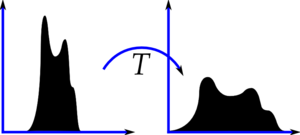Thresholding
Hi friends,
This article is about
image thresholding and its different functionalities available in OpenCV. Thresholding converts a grayscale image to a binary image (most of the time). It is highly useful for image segmentation, creating markers, masks etc.
Simple Thresholding
Here, the matter is straight forward. If pixel value is greater than a arbitrary value, it is assigned one value (may be white), else it is assigned another value (may be white).
The function used is
threshold(). First param is the source image, which
should be a grayscale image. Second param is the threshold value which is used to classify the pixel values. Third param is the maxVal which represents the value to be given if pixel value is more than (sometimes less than) the threshold value. OpenCV provides different styles of thresholding and it decided by the fourth parameter of the function. Different types are:
- cv2.THRESH_BINARY
- cv2.THRESH_BINARY_INV
- cv2.THRESH_TRUNC
- cv2.THRESH_TOZERO
- cv2.THRESH_TOZERO_INV
Two outputs are obtained. First one is a retval which I will explain later. Second output is our thresholded image.
import cv2
import numpy as np
from matplotlib import pyplot as plt
img = cv2.imread('messi2.jpg',0)
ret,thresh1 = cv2.threshold(img,127,255,cv2.THRESH_BINARY)
ret,thresh2 = cv2.threshold(img,127,255,cv2.THRESH_BINARY_INV)
ret,thresh3 = cv2.threshold(img,127,255,cv2.THRESH_TRUNC)
ret,thresh4 = cv2.threshold(img,127,255,cv2.THRESH_TOZERO)
ret,thresh5 = cv2.threshold(img,127,255,cv2.THRESH_TOZERO_INV)
thresh = ['img','thresh1','thresh2','thresh3','thresh4','thresh5']
for i in xrange(6):
plt.subplot(2,3,i+1),plt.imshow(eval(thresh[i]),'gray')
plt.title(thresh[i])
plt.show()
Result :
Adaptive Thresholding
In the previous section, we used a global value as threshold value. But it may not be good in all the conditions where image has different lighting conditions in different areas. In that case, we go for adaptive thresholding. In this, the algorithm calculate the threshold for a small regions of the image. So we get different thresholds for different regions of the same image and it gives us better results for images with varying illumination.
It has three ‘special’ input params and only one output param.
- Adaptive Method - It decides how thresholding value is calculated.
- cv2.ADAPTIVE_THRESH_MEAN_C : threshold value is the mean of neighbourhood area.
- cv2.ADAPTIVE_THRESH_GAUSSIAN_C : threshold value is the weighted sum of neighbourhood values where weights are a gaussian window.
- Block Size - It decides the size of neighbourhood area.
- C - It is just a constant which is subtracted from the mean or weighted mean calculated.
Below piece of code compares global thresholding and adaptive thresholding for an image with varying illumination.
import cv2
import numpy as np
from matplotlib import pyplot as plt
img = cv2.imread('dave.jpg',0)
img = cv2.medianBlur(img,5)
ret,th1 = cv2.threshold(img,127,255,cv2.THRESH_BINARY)
th2 = cv2.adaptiveThreshold(img,255,cv2.ADAPTIVE_THRESH_MEAN_C,\
cv2.THRESH_BINARY,11,2)
th3 = cv2.adaptiveThreshold(img,255,cv2.ADAPTIVE_THRESH_GAUSSIAN_C,\
cv2.THRESH_BINARY,11,2)
plt.subplot(2,2,1),plt.imshow(img,'gray')
plt.title('input image')
plt.subplot(2,2,2),plt.imshow(th1,'gray')
plt.title('Global Thresholding')
plt.subplot(2,2,3),plt.imshow(th2,'gray')
plt.title('Adaptive Mean Thresholding')
plt.subplot(2,2,4),plt.imshow(th3,'gray')
plt.title('Adaptive Gaussian Thresholding')
plt.show()
Otsu’s Binarization
In the first section, I told you there is a second parameter
retVal. Its use comes when we go for Otsu’s Binarization. So what is this thing?
In global thresholding, we used an arbitrary value for threshold value, right? So, how can we know a value we selected is good or not? Answer is, trial and error method. But consider a bimodal image. For that image, we can approximately take a value in the middle of those peaks as threshold value, right ? That is what Otsu binarization does.
So in simple words, it automatically calculates a threshold value from image histogram for a
bimodal image.
(For images which are not bimodal, binarization won’t be accurate.)
For this, our
cv2.threshold() function is used, but pass an extra flag,
cv2.THRESH_OTSU. For threshold value, simply pass zero. Then the algorithm finds the optimal threshold value and returns you as the second output, retVal. If Otsu thresholding is not used, retVal is same as the threshold value you used.
Check out below example. Input image is a noisy image. First I applied global thresholding for a value of 127. Then I applied Otsu’s thresholding directly. Later I filtered it with a 5x5 gaussian kernel to remove the noise, then applied Otsu thresholding. See how noise filtering improves the result in Figure [fig:thresh
3].
img = cv2.imread('noisy2.png',0)
# global thresholding
ret1,th1 = cv2.threshold(img,127,255,cv2.THRESH_BINARY)
# Otsu's thresholding
ret2,th2 = cv2.threshold(img,0,255,cv2.THRESH_BINARY+cv2.THRESH_OTSU)
# Otsu's thresholding after Gaussian filtering
blur = cv2.GaussianBlur(img,(5,5),0)
ret3,th3 = cv2.threshold(blur,0,255,cv2.THRESH_BINARY+cv2.THRESH_OTSU)
# plot all the images and their histograms
titles = ['img','histogram1','th1',
'img','histogram2','th2',
'blur','histogram3','th3']
for i in xrange(3):
plt.subplot(3,3,i*3+1),plt.imshow(eval(titles[i*3]),'gray')
plt.title(titles[i*3])
plt.subplot(3,3,i*3+2),plt.hist(eval(titles[i*3]).ravel(),256)
plt.title(titles[i*3+1])
plt.subplot(3,3,i*3+3),plt.imshow(eval(titles[i*3+2]),'gray')
plt.title(titles[i*3+2])
plt.show()
How Otsu’s Binarization works?
That is very simple. Since we are working with bimodal images, Otsu’s algorithm tries to find a threshold value which minimizes the
weighted within-class variance given by the relation :
$$ \sigma_w^2(t) = q_1(t)\sigma_1^2(t)+q_2(t)\sigma_2^2(t) $$
where
$$ q_1(t) = \sum_{i=1}^{t} P(i) \quad \& \quad q_1(t) = \sum_{i=t+1}^{I} P(i) $$
$$ \mu_1(t) = \sum_{i=1}^{t} \frac{iP(i)}{q_1(t)} \quad \& \quad \mu_2(t) = \sum_{i=t+1}^{I} \frac{iP(i)}{q_2(t)} $$
$$ \sigma_1^2(t) = \sum_{i=1}^{t} [i-\mu_1(t)]^2 \frac{P(i)}{q_1(t)} \quad \& \quad \sigma_2^2(t) = \sum_{i=t+1}^{I} [i-\mu_1(t)]^2 \frac{P(i)}{q_2(t)} $$
So our plan is to find the value of
$ t $ which minimizes the equation [eq:otsu] and it can be done simply in Numpy as follows :
img = cv2.imread('noisy2.png',0)
blur = cv2.GaussianBlur(img,(5,5),0)
# find normalized_histogram, and its cum_sum
hist = cv2.calcHist([blur],[0],None,[256],[0,256])
hist_norm = hist.ravel()/hist.max()
Q = hist_norm.cumsum()
bins = np.arange(256)
fn_min = np.inf
thresh = -1
for i in xrange(1,256):
p1,p2 = np.hsplit(hist_norm,[i]) # probabilities
q1,q2 = Q[i],Q[255]-Q[i] # cum sum of classes
b1,b2 = np.hsplit(bins,[i]) # weights
# finding means and variances
m1,m2 = np.sum(p1*b1)/q1, np.sum(p2*b2)/q2
v1,v2 = np.sum(((b1-m1)**2)*p1)/q1,np.sum(((b2-m2)**2)*p2)/q2
# calculates the minimization function
fn = v1*q1 + v2*q2
if fn < fn_min:
fn_min = fn
thresh = i
# find otsu's threshold value with OpenCV function
ret, otsu = cv2.threshold(blur,0,255,cv2.THRESH_BINARY+cv2.THRESH_OTSU)
print thresh,ret
(There are some optimizations available for this algorithm and that is left for interested people.)
So that's for today. It is a simple and basic tutorial.
Abid K.















